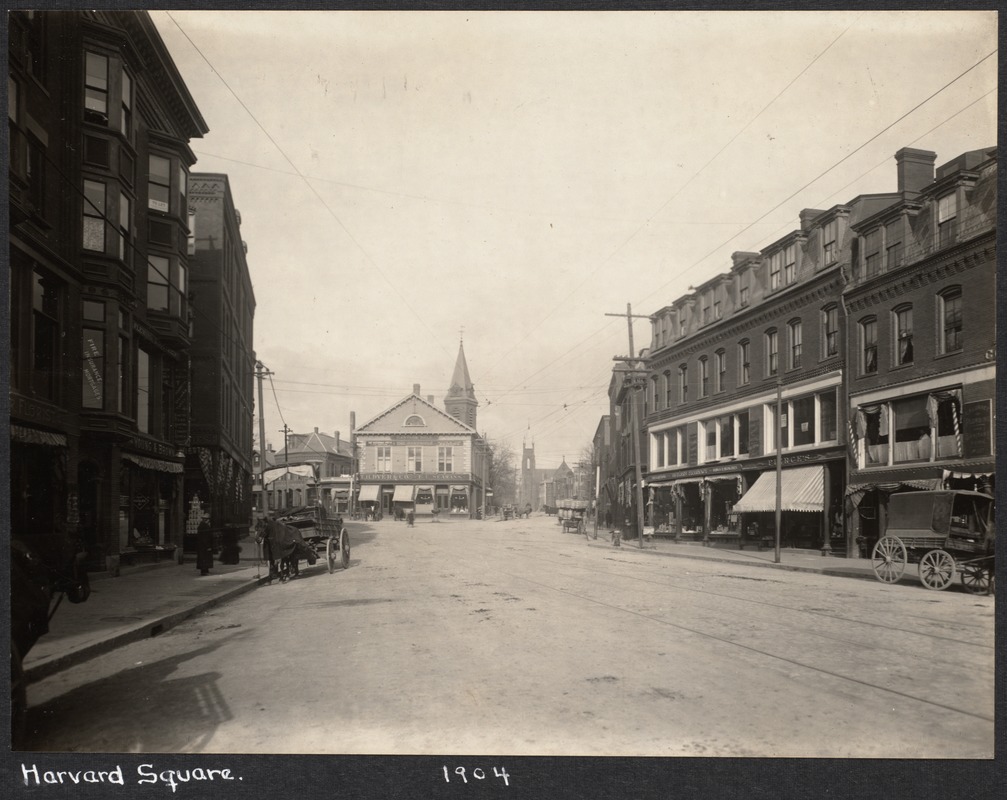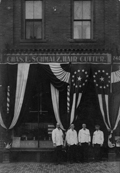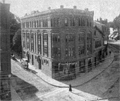|
The Society
Historical Information
Photo & Map Collections
Exploring Brookline
Links
Program Archives
|
Brookline Village
 |
Brookline Village, December 1899
This photograph was taken in December 1899 by the “special photographer” of The Suburban newspaper and was printed on the front page of the January 2, 1900 issue.
In the darkened building on the left:
- 220 Washington St., a partial view of F. E. Palmer, Florist
- 222 Washington St., sign in the window for the upstairs office of Frank G. Russell, Real Estate and Fire Insurance
- 222 Washington St., the upstairs office of John F. Fleming, gasfitter
- 224 Washington St., Young & Brown, pharmacy
In the center:
- 279 Washington St.. the store of Nelson C. Thompson who took over the furniture and upholstery business from his father.
- 13 Harvard Sq., the grocery store of T. H. Dyer.
- 11 Harvard Sq., Frank F. Seamens, Groceries
- 4 Harvard St. (on the right side of the Harvard Hall building), entrances to upstairs businesses: Brookline Co-op Bank; Riverdale Press; Brookline Chronicle, Charles A.W. Spencer, proprietor.
- 8 Harvard St. (on the right side of the Harvard Hall building), the sign for Charlie Sing, Laundry is visible.
On the right:
- 239-241 Washington St., William H. Butler, Apothecary
- 235 Washington St., Everett E. Pierce, baker and caterer, right side of the first Colonnade Building
- 227 Washington St., upstairs sign for Charles A. Lunney, Plumber is visible, above the wagon, in the second Colonnade Building
[Source: Digital Commonwealth]
|
 |
Harvard Square, Brookline Village, August 11, 1903
This photo most likely shows the final stage of the building at 11-13 Harvard Square. On the left,with its delivery wagons parked out front, is T. H. Dyer, Provisions. On the right, at #13 Harvard Sq., is Frank F. Seamens, Groceries. It appears that Lucius N. Danforth, a clerk at the Dyer store for two decades and at the George Joyce store there before that, has taken over the store. But the Danforth store will be short-lived: the building that exists today is about to be constructed there with Rhodes Bros. taking over occupancy.
[Source: Digital Commonwealth]
|
 |
Harvard Hall, 1905
This is a rare photo of the Harvard Hall building just prior to its replacement after a battle with the town and the invocation of eminent domain. The town needed to widen both Washington St. and Harvard St. and was literally shaving off sections of the building which sat at the apex of the two streets. The grocer, T. H. Dyer, insisted on remaining open and the building owner, in litigation with the town, covered the reduced and now-asymmetrical building with makeshift boarding.
[Source: Historic New England]
|
 |
Harvard Square, Brookline Village, 1905
Looking north from Washington St.
|
 |
Harvard Square, April 11, 1906
Looking north on Harvard St. from Harvard Square. Rhodes Bros., Groceries and Provisions, which opened at the very end of 1905. This building, which still stands today, replaced the Harvard Hall Building which, following a contentious struggle with the town, was taken down after being downsized to accommodate the widening of Harvard St. Rhodes Bros. remained there until World War II.
[Source: Digital Commonwealth]
|
 |
Harvard Square, Brookline Village, 1907
The Harvard Hall building has been replaced with the building that still stands today.
|
 |
Harvard Square, Brookline Village, Circa 1908
The majority of the structures in this photo are still standing. From left to right:
- Rhodes Bros., Groceries and Provisions, which opened at the very end of 1905. This building, which still stands today, replaced the Harvard Hall Building which, following a contentious struggle with the town, was taken down after being downsized to accommodate the widening of Harvard St. Rhodes Bros. remained there until World War II.
- Cast-iron watering stand for horses, with a lower rim for dogs, manufactured by Henry F. Jenks. More information
- The horse of the cheese-delivery wagon drinking from the fountain.
- The steeple of the Baptist Church, later the First Presbyterian Church, directly behind Rhodes Bros. It burned on New Year's Eve 1960-61
- The steeple of St. Mary’s church
- Woman exiting and woman entering the trolley car
- The National Bank building
- The Woman's Exchange, the one-story building at 5 Harvard Sq. Woman's Exchanges were part of a movement that enabled impoverished women to sell their wares in consignment stores whose organizations were run by women.
- The doorway at #2 Harvard Sq. leading to a rooming house called Somerset House. The sign announces Board and Room By Day or Week, Single Meals
- James Rooney Boots & Shoes at #1 Harvard Sq.
[Source: Joel Shield]
|
 |
Harvard Square, Brookline Village, 1910s
Looking north from Washington St.
|
 |
Harvard Square, Brookline Village, Boylston St. Trolley, 1910
Looking north from Washington St.
|
 |
Harvard Square, Brookline Village, 1929
Looking north from Washington St.
|
 |
Harvard Sq., Brookline Village, circa 1910
Identified locations from left to right:
- Rhodes Bros., Groceries and Provisions. Opened in 1906 in the new building at 10-11 Harvard Sq. which still stands today.
- The two horses of the Twin Elm Spring Water delivery wagon drinking from the fountain. The banner on top advertises “Famous For Purity”
- The top of the steeple of the Baptist Church visible behind Rhodes Bros.
- An unidentified wagon with a man standing in its rear possibly making a delivery to a rear entrance of Rhodes Bros.
- St. Mary’s church at the corner of Harvard St. and Linden Place.
- The sign advertising « Ice Cream » of the Papouleas Confectionery store at 39 Harvard St.
- The store sign of T. H. Dyer, Provisions, above the awning, is visible at 33 Harvard St.
- The large brick building of the Brookline National Bank on the corner of Kent St.
[Source: Brookline Preservation Department]
|
 |
Brookline Village, January 9, 1922
Looking north on Harvard St. from Kent St. Photo by Henry A. Varney, Brookline town engineer.
- On the left is the smaller tower of the Baptist Church on the southwest corner with Pierce St., no longer standing
- In the far distance is the steeple of St. Mary's Church of the Assumption, still standing
- In the immediate foreground is the First National Bank building, #1-5 Harvard St., still standing
- Following the bank building is the building at #7–15 Harvard St. Seen are the signs for Wallace Ozon, dentist at #7 and Jennie Wilson, milliner, at #9. Still standing.
[Source: Digital Commonwealth]
|
 |
Charles E. Schmalz, Haircutter, circa 1901
238 Washington St., Brookline Village, the southwest corner of Davis Ave. The St. Andrew Building, still standing, remains virtually unchanged today. Traceable names of those working at the shop in 1901 are hairdressers Charles E. Schmalz, Adolf Koffinke, William Pebler, William Pickering, and John J. Moloney and boot black Samuel Short.
Charles Schmalz had a remarkably long working life in Brookline and maintained his business at 238 Washington for over fifty years. Here is his Brookline timeline:
- [1883-1896] By the age of 18, and possibly several years before that, he begins work at the barbershop of Peter Keiser at 157 Washington St., situated roughly at the western edge of today's Hearthstone Plaza. He lives upstairs above the shop until 1887. It appears that Keiser is his uncle.
- [1895] Runs the shop at 157 Washington St. Peter Keiser remains the owner but no longer works there.
- [1897] Opens his own shop at 238 Washington St. Peter Keiser returns to his old business.
- [1897-1949] Continues to maintain his business at 238 Washington St., apparently working there into the 1940s when he would have been in his seventies
- [1954] Dies at the age of 88
[Source: Joel Shield]
|
 |
Harvard Square, Brookline Village, 1899
At the apex of Harvard and Washington Streets in Brookline Village, looking northwest on Washington St. The building on the right is the post office, at 283 Washington St. Identifiable businesses in the store on the left are the Postal Telegraph & Cable Co. and Frank A. Carnes, Real Estate at 289 Washington St.
This photo has long been misidentified (e.g. page 59 in Brookline, Massachusetts, A Pictorial History by Jean Kramer) as being part of the town’s 1905 bicentennial celebration. The clue to its real identity is the anomaly of the large picture of a man above the store fronts. It is Admiral George Dewey and he is being feted for his victory at the Battle of Manila in the Spanish American War. When Dewey returned from the Philippines to the United States on September 27, 1899, large parades in his honor were held in several major cities, including Boston on October 14, 1899 and it is probable that Brookline was also celebrating his victory in the fall of 1899, captured in this photo.
[Source: Digital Commonwealth]
|
 |
Brookline Village, Washington St. & Davis Ave, early 1860s
Washington St. in the heart of the village, looking northwest, at the corner of Washington Place, today's Davis Ave. Benjamin Davis House, built in 1760, demolished around 1867. Large tree and fences can be viewed in other photos from the 1860s.
|
 |
Brookline Village, Northwest Corner, Washington St. & Davis Ave.
Washington St. going north to the right; Davis on the left. The second floor was used by dancing and singing schools. Replaced by the brick Seamans building in 1889.
|
 |
Brookline Village, Northwest Corner, Washington St. & Davis Ave.
This building, still standing at 256 Washington St., was constructed in 1889 by the Seamans as a replacement for their two-story wood-framed store. In 1911-12, William Dexter Paine, stationer, moved his store into the building from the longtime location at 239 Washington St. To the right, at 260 Washington St. is the business of Nelson C. Thompson, upholsterer, previously located directly across the street. Steverman & Gibbons, electricians, are at 264 and H. J. Murray, plumber, is at 266 Washington St. These businesses were collectively present here from 1912 to 1917.
[Source: Digital Commonwealth]
|
 |
Brookline Village, Northwest Corner, Washington St. & Davis Ave.
Washington St. going north to the right; Davis just off screen on the left. James M. Seamans moved his grocery store, that had been in the lower Village since 1848, to this location in 1865. The Seaman's second floor was used by dancing and singing schools. In 1889, the store was replaced by the four-story brick building that remains today. Martin Kingman maintained a dry goods store next door from 1865 until 1875 when he sold the business to his assistant, Elizabeth Swift.
[Source: Digital Commonwealth]
|
 |
J. M. Seamans & Co.
256 Washington St., corner of Davis Ave. In 1889, James Manning Seamans replaced his wooden two-story store with this brick building that still stands. His son, Manning Seamans, took over the business from his father. Upon the latter’s death in 1910, the business was closed and replaced by William Dexter Paine, Stationer.
[Source: Brookline Preservation Department]
|
 |
J. M. Seamans & Co.
256 Washington St., corner of Davis Ave. In 1889, James Manning Seamans replaced his wooden two-story store with this brick building that still stands. His son, Manning Seamans, took over the business from his father. Upon the latter’s death in 1910, the business was closed and replaced by William Dexter Paine, Stationer.
One possible speculative configuration for the three men is, from left to right: unknown employee, Manning Seamans, James Manning Seamans.
[Source: Brookline Preservation Department]
|
|